sensor MERCEDES-BENZ B-CLASS HATCHBACK 2015 Owners Manual
[x] Cancel search | Manufacturer: MERCEDES-BENZ, Model Year: 2015, Model line: B-CLASS HATCHBACK, Model: MERCEDES-BENZ B-CLASS HATCHBACK 2015Pages: 293, PDF Size: 10.83 MB
Page 8 of 293
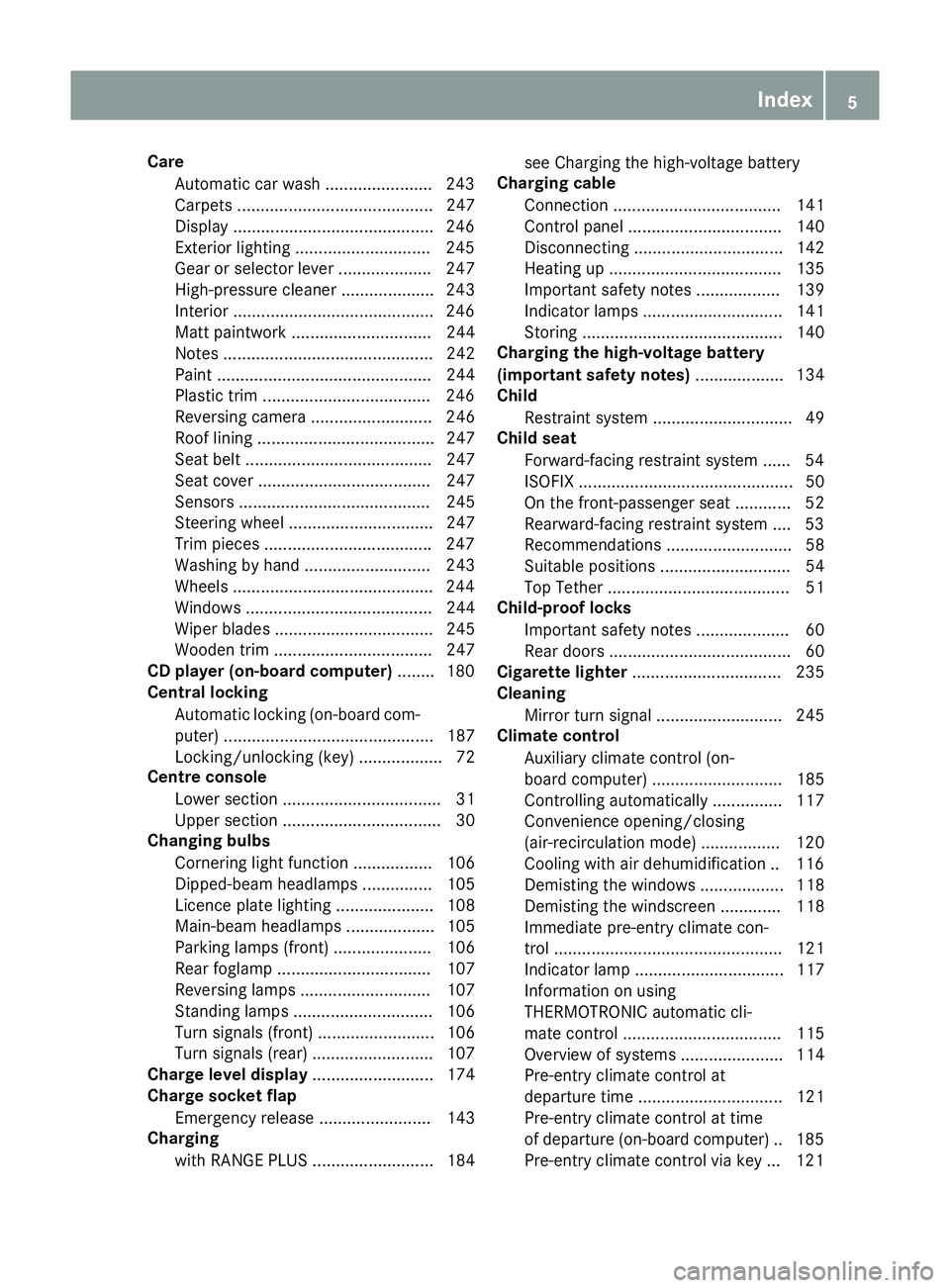
Care
Automatic car wash ...................... .243
Carpets .......................................... 247
Display .......................................... .246
Exterior lighting ............................ .245
Gear or selector lever .................... 247
High-pressure cleaner .................... 243
Interior .......................................... .246
Matt paintwork .............................. 244
Notes ............................................. 242
Paint .............................................. 244
Plastic trim ................................... .246
Reversing camera .......................... 246
Roof lining ...................................... 247
Seat belt ........................................ 247
Seat cover ..................................... 247
Sensors ......................................... 245
Steering wheel ............................... 247
Trim pieces ................................... .247
Washing by hand ........................... 243
Wheels .......................................... .244
Windows ........................................ 244
Wiper blades .................................. 245
Wooden trim .................................. 247
CD player (on-board computer) ........180
Central locking
Automatic locking (on-board com-
puter) ............................................. 187
Locking/unlocking (key ).................. 72
Centre console
Lower section .................................. 31
Upper section .................................. 30
Changing bulbs
Cornering light function ................. 106
Dipped-beam headlamp s............... 105
Licence plate lighting ..................... 108
Main-beam headlamp s................... 105
Parking lamps (front) ..................... 106
Rear foglamp ................................. 107
Reversing lamps ............................ 107
Standing lamps .............................. 106
Turn signals (front) ......................... 106
Turn signals (rear) .......................... 107
Charge level display .......................... 174
Charge socket flap
Emergency release ........................ 143
Charging
with RANGE PLUS .......................... 184 see Charging the high-voltage battery
Charging cable
Connection .................................... 141
Control panel ................................. 140
Disconnecting ................................ 142
Heating up ..................................... 135
Important safety notes .................. 139
Indicator lamps .............................. 141
Storing ........................................... 140
Charging the high-voltage battery
(important safety notes) ................... 134
Child
Restraint system .............................. 49
Child seat
Forward-facing restraint system ...... 54
ISOFIX .............................................. 50
On the front-passenger sea t............ 52
Rearward-facing restraint system .... 53
Recommendations ........................... 58
Suitable positions ............................ 54
Top Tether ....................................... 51
Child-proof locks
Important safety notes .................... 60
Rear doors ....................................... 60
Cigarette lighter ................................ 235
Cleaning
Mirror turn signal ........................... 245
Climate control
Auxiliary climate control (on-
board computer) ............................ 185
Controlling automaticall y............... 117
Convenience opening/closing
(air-recirculation mode) ................. 120
Cooling with air dehumidification .. 116
Demisting the windows .................. 118
Demisting the windscreen ............. 118
Immediate pre-entry climate con-
trol ................................................. 121
Indicator lamp ................................ 117
Information on using
THERMOTRONIC automatic cli-
mate control .................................. 115
Overview of systems ...................... 114
Pre-entry climate control at
departure time ............................... 121
Pre-entry climate control at time
of departure (on-board computer) .. 185 Pre-entry climate control via key ... 121 Index
5
Page 13 of 293
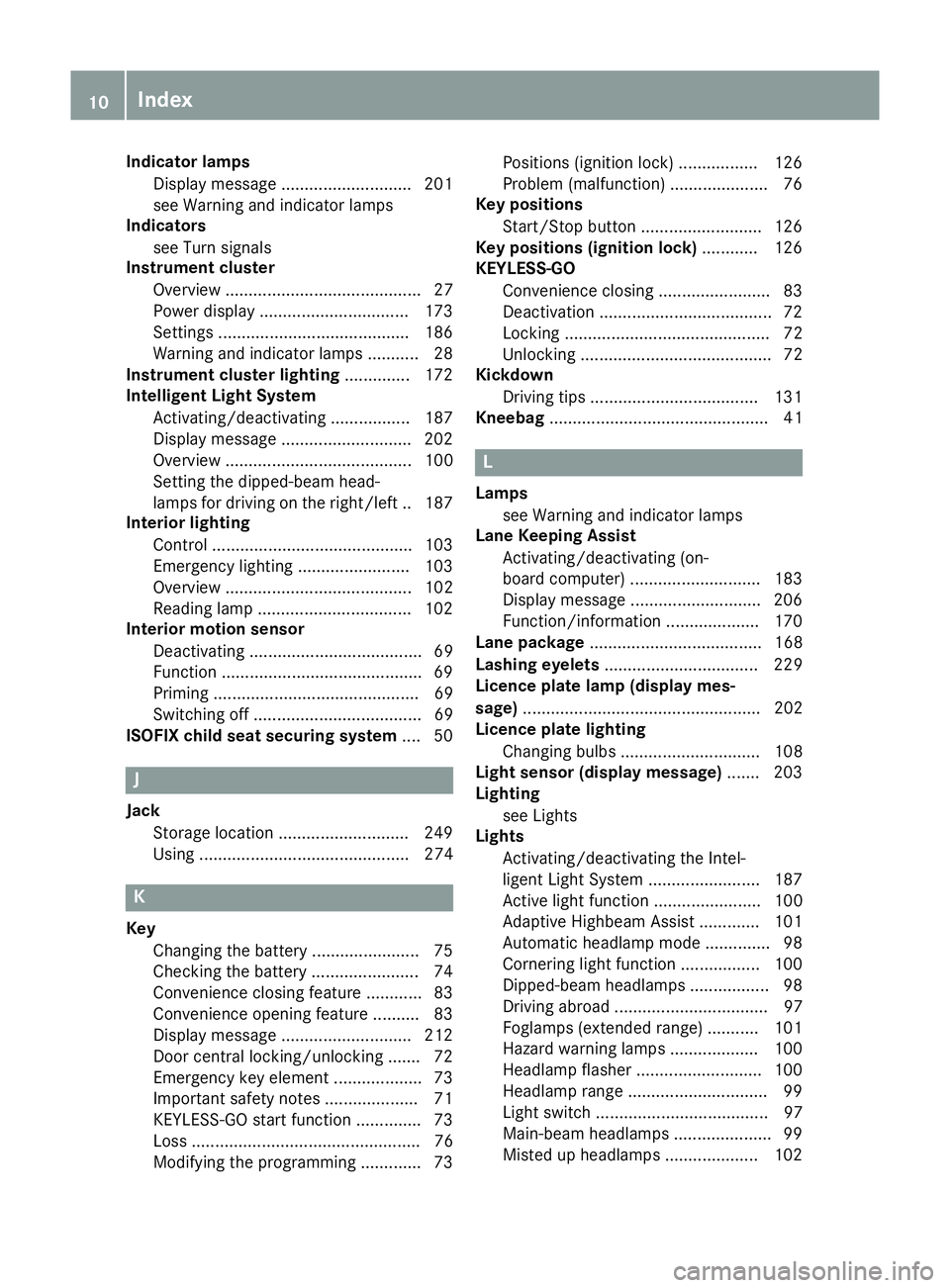
Indicator lamps
Display message ............................ 201
see Warning and indicator lamps
Indicators
see Turn signals
Instrument cluster
Overview .......................................... 27
Power display ................................ 173
Settings ........................................ .186
Warning and indicator lamps ........... 28
Instrument cluster lighting .............. 172
Intelligent Light System
Activating/deactivating ................. 187
Display message ............................ 202
Overview ........................................ 100
Setting the dipped-beam head-
lamps for driving on the right/left .. 187
Interior lighting
Control .......................................... .103
Emergency lighting ........................ 103
Overview ........................................ 102
Reading lamp ................................. 102
Interior motion sensor
Deactivating ..................................... 69
Function .......................................... .69
Priming ............................................ 69
Switching off .................................... 69
ISOFIX child seat securing system ....50J
Jack Storage location ............................2 49
Using ............................................. 274 K
Key Changing the battery ....................... 75
Checking the battery ....................... 74
Convenience closing feature ............ 83
Convenience opening feature .......... 83
Display message ............................ 212
Door central locking/unlocking ....... 72
Emergency key element ................... 73
Important safety notes .................... 71
KEYLESS-GO start function .............. 73
Loss ................................................. 76
Modifying the programming ............. 73 Positions (ignition lock) ................. 126
Problem (malfunction) ..................... 76
Key positions
Start/Stop button .......................... 126
Key positions (ignition lock) ............ 126
KEYLESS-GO
Convenience closing ........................ 83
Deactivation ..................................... 72
Locking ............................................ 72
Unlocking ......................................... 72
Kickdown
Driving tips ................................... .131
Kneebag ............................................... 41 L
Lamps see Warning and indicator lamps
Lane Keeping Assist
Activating/deactivating (on-
board computer) ............................ 183
Display message ............................ 206
Function/informatio n.................... 170
Lane package ..................................... 168
Lashing eyelets ................................. 229
Licence plate lamp (display mes-
sage) ................................................... 202
Licence plate lighting
Changing bulb s.............................. 108
Light sensor (display message) ....... 203
Lighting
see Lights
Lights
Activating/deactivating the Intel-
ligent Light System ........................ 187
Active light function ....................... 100
Adaptive Highbeam Assist ............. 101
Automatic headlamp mode .............. 98
Cornering light function ................. 100
Dipped-beam headlamp s................. 98
Driving abroad ................................. 97
Foglamps (extended range) ........... 101
Hazard warning lamps ................... 100
Headlamp flashe r........................... 100
Headlamp range .............................. 99
Light switch ..................................... 97
Main-beam headlamp s..................... 99
Misted up headlamp s.................... 102 10
Index
Page 15 of 293
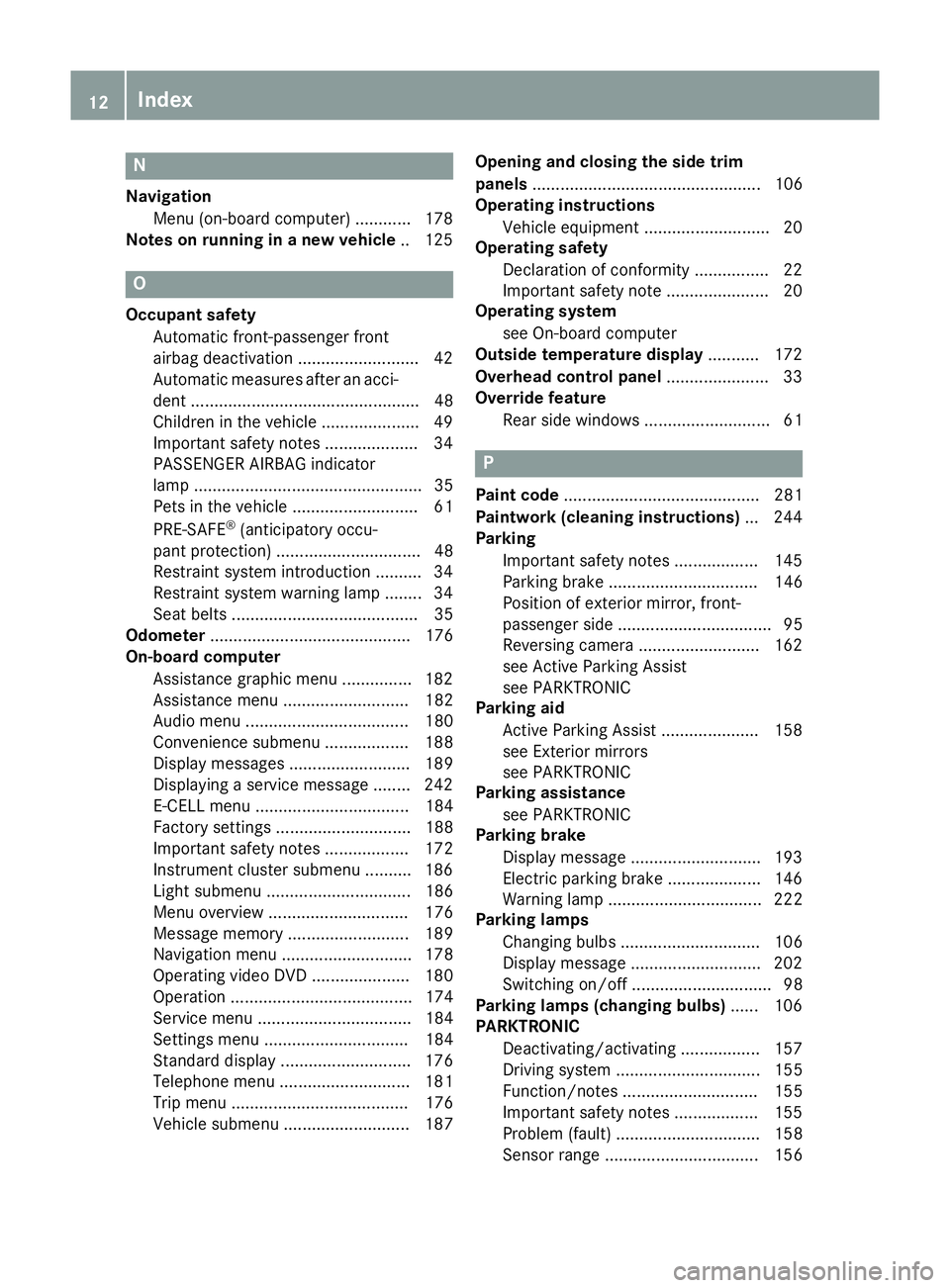
N
Navigation Menu (on-board computer) ............ 178
Notes on running in a new vehicle .. 125O
Occupant safety Automatic front-passenger front
airbag deactivation .......................... 42
Automatic measures after an acci-
dent ................................................. 48
Children in the vehicle ..................... 49
Important safety note s.................... 34
PASSENGER AIRBAG indicator
lamp ................................................. 35
Pets in the vehicle ........................... 61
PRE-SAFE ®
(anticipatory occu-
pant protection) ............................... 48
Restraint system introduction .......... 34
Restraint system warning lamp ........ 34
Seat belts ........................................ 35
Odometer ........................................... 176
On-board computer
Assistance graphic menu ............... 182
Assistance menu ........................... 182
Audio menu ................................... 180
Convenience submenu .................. 188
Display messages .......................... 189
Displaying a service message ........ 242
E‑CELL menu ................................. 184
Factory settings ............................. 188
Important safety notes .................. 172
Instrument cluster submenu .......... 186
Light submenu ............................... 186
Menu overview .............................. 176
Message memory .......................... 189
Navigation menu ............................ 178
Operating video DVD ..................... 180
Operation ....................................... 174
Service menu ................................. 184
Settings menu ............................... 184
Standard display ............................ 176
Telephone menu ............................ 181
Trip menu ...................................... 176
Vehicle submenu ........................... 187 Opening and closing the side trim
panels
................................................. 106
Operating instructions
Vehicle equipment ........................... 20
Operating safety
Declaration of conformity ................ 22
Important safety note ...................... 20
Operating system
see On-board computer
Outside temperature display ........... 172
Overhead control panel ...................... 33
Override feature
Rear side window s........................... 61 P
Paint code .......................................... 281
Paintwork (cleaning instructions) ... 244
Parking
Important safety notes .................. 145
Parking brake ................................ 146
Position of exterior mirror, front-
passenger side ................................. 95
Reversing camera .......................... 162
see Active Parking Assist
see PARKTRONIC
Parking aid
Active Parking Assist ..................... 158
see Exterior mirrors
see PARKTRONIC
Parking assistance
see PARKTRONIC
Parking brake
Display message ............................ 193
Electric parking brake .................... 146
Warning lamp ................................. 222
Parking lamps
Changing bulb s.............................. 106
Display message ............................ 202
Switching on/of f.............................. 98
Parking lamps (changing bulbs) ...... 106
PARKTRONIC
Deactivating/activating ................. 157
Driving system ............................... 155
Function/note s............................. 155
Important safety notes .................. 155
Problem (fault) ............................... 158
Sensor range ................................. 156 12
Index
Page 16 of 293
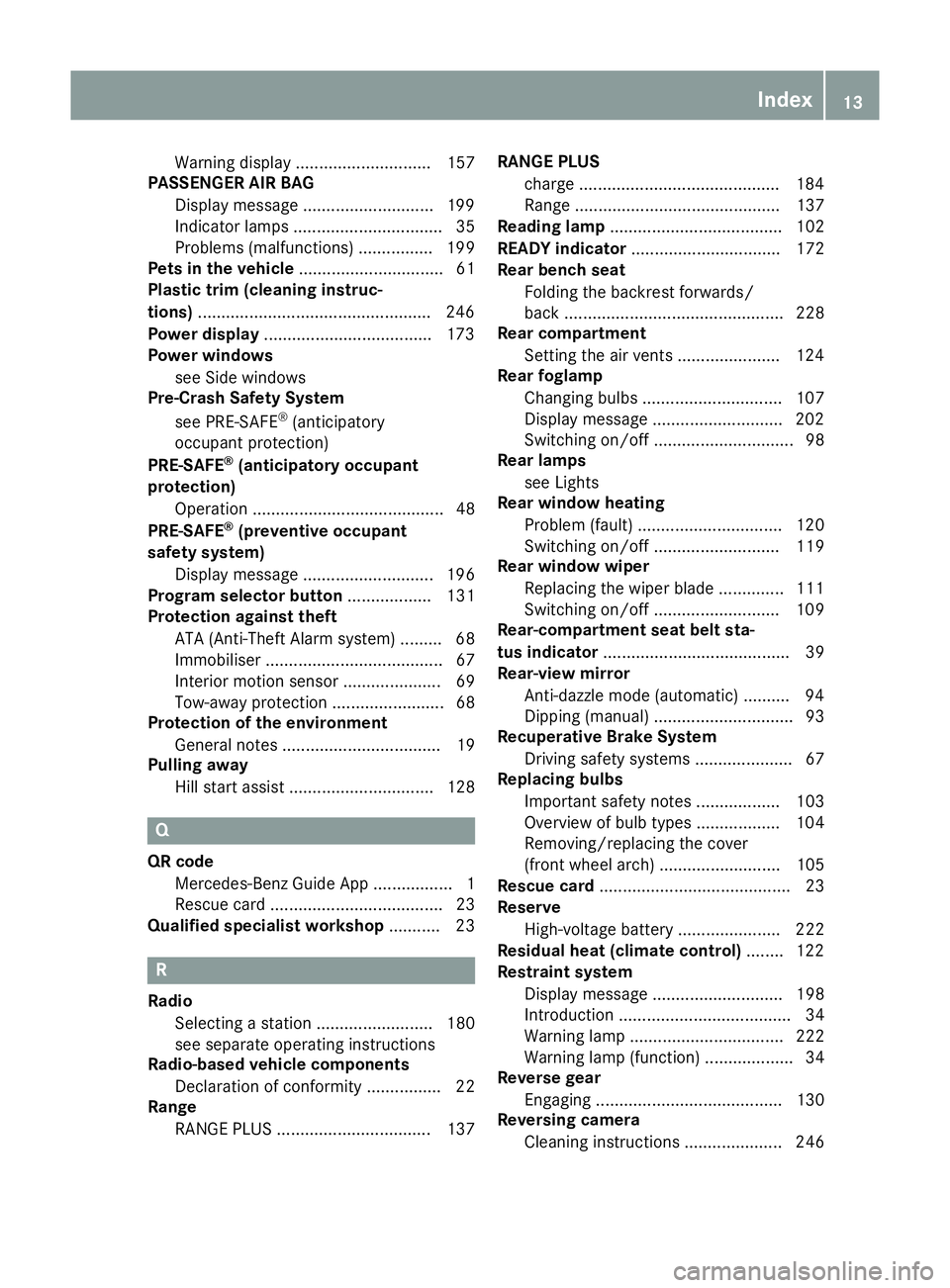
Warning display ............................. 157
PASSENGER AIR BAG
Display message ............................1 99
Indicator lamps ................................ 35
Problems (malfunctions) ................ 199
Pets in the vehicle ............................... 61
Plastic trim (cleaning instruc-
tions) ................................................. .246
Power display ................................... .173
Power windows
see Side windows
Pre-Crash Safety System
see PRE-SAFE ®
(anticipatory
occupant protection)
PRE-SAFE ®
(anticipatory occupant
protection)
Operation ......................................... 48
PRE-SAFE ®
(preventive occupant
safety system)
Display message ............................ 196
Program selector button .................. 131
Protection against theft
ATA (Anti-Theft Alarm system) ......... 68
Immobiliser ...................................... 67
Interior motion sensor ..................... 69
Tow-away protection ........................ 68
Protection of the environment
General notes .................................. 19
Pulling away
Hill start assist ............................... 128 Q
QR code Mercedes-Benz Guide App ................. 1
Rescue card ..................................... 23
Qualified specialist workshop ........... 23R
Radio Selecting a station ......................... 180
see separate operating instructions
Radio-based vehicle components
Declaration of conformity ................ 22
Range
RANGE PLUS ................................. 137 RANGE PLUS
charge .......................................... .184
Range ............................................ 137
Reading lamp ..................................... 102
READY indicator ................................ 172
Rear bench seat
Folding the backrest forwards/
back ............................................... 228
Rear compartment
Setting the air vents ..................... .124
Rear foglamp
Changing bulbs .............................. 107
Display message ............................ 202
Switching on/off .............................. 98
Rear lamps
see Lights
Rear window heating
Problem (fault) ............................... 120
Switching on/off ........................... 119
Rear window wiper
Replacing the wiper blade .............. 111
Switching on/off ........................... 109
Rear-compartment seat belt sta-
tus indicator ........................................ 39
Rear-view mirror
Anti-dazzle mode (automatic) .......... 94
Dipping (manual ).............................. 93
Recuperative Brake System
Driving safety systems ..................... 67
Replacing bulbs
Important safety notes .................. 103
Overview of bulb types .................. 104
Removing/replacing the cover
(front wheel arch) .......................... 105
Rescue card ......................................... 23
Reserve
High-voltage battery ...................... 222
Residual heat (climate control) ........ 122
Restraint system
Display message ............................ 198
Introduction ..................................... 34
Warning lamp ................................. 222
Warning lamp (function) ................... 34
Reverse gear
Engaging ........................................ 130
Reversing camera
Cleaning instructions ..................... 246 Index
13
Page 17 of 293
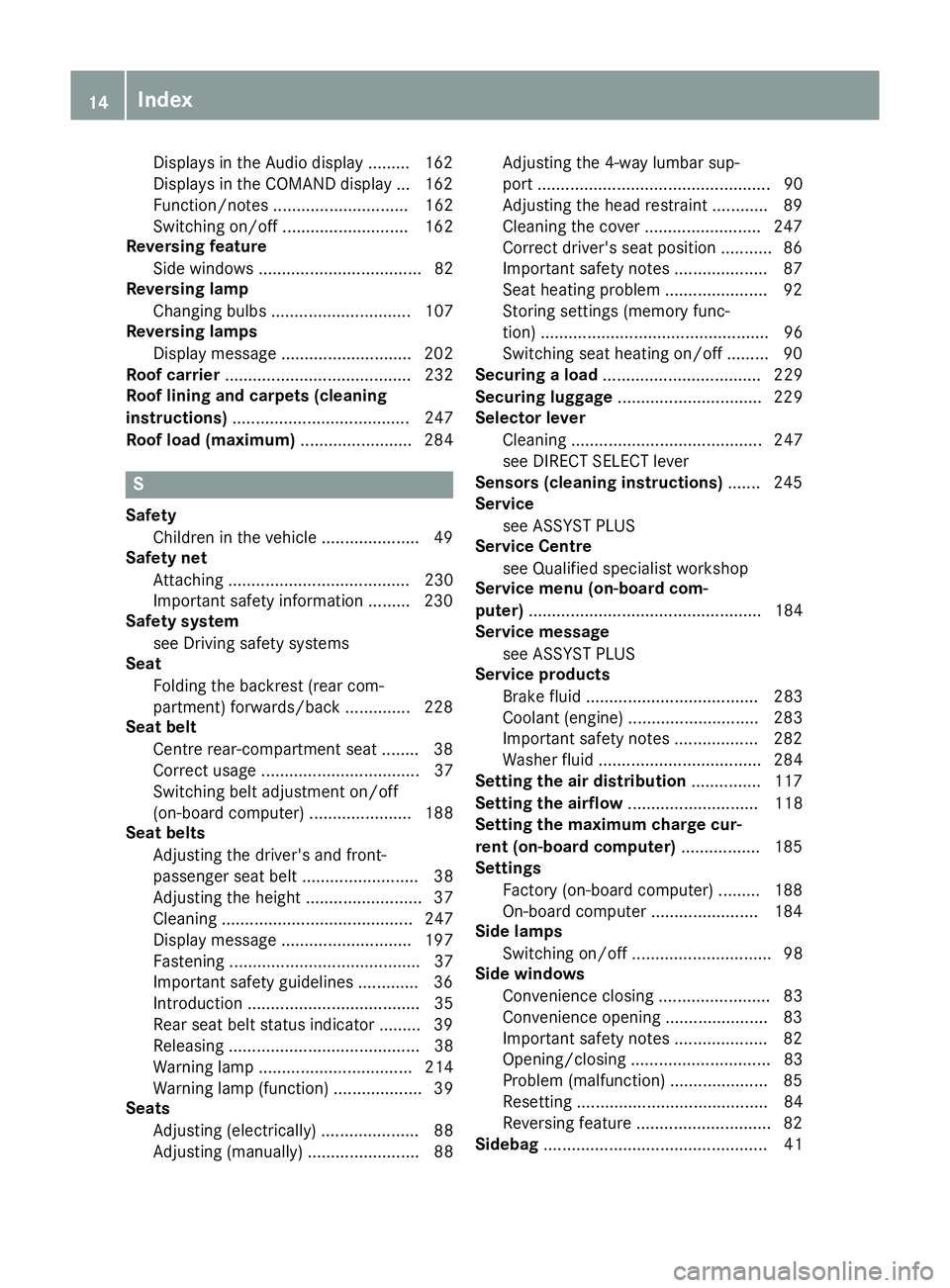
Displays in the Audio displa
y......... 162
Displays in the COMAND display ... 162
Function/note s............................. 162
Switching on/of f........................... 162
Reversing feature
Side windows ................................... 82
Reversing lamp
Changing bulb s.............................. 107
Reversing lamps
Display message ............................ 202
Roof carrier ........................................ 232
Roof lining and carpets (cleaning
instructions) ...................................... 247
Roof load (maximum) ........................ 284S
Safety Children in the vehicle ..................... 49
Safety net
Attaching ....................................... 230
Important safety information ......... 230
Safety system
see Driving safety systems
Seat
Folding the backrest (rear com-
partment) forwards/back .............. 228
Seat belt
Centre rear-compartment sea t........ 38
Correct usage .................................. 37
Switching belt adjustment on/off
(on-board computer) ...................... 188
Seat belts
Adjusting the driver's and front-
passenger seat belt ......................... 38
Adjusting the height ......................... 37
Cleaning ......................................... 247
Display message ............................ 197
Fastening ......................................... 37
Important safety guidelines ............. 36
Introduction ..................................... 35
Rear seat belt status indicator ......... 39
Releasing ......................................... 38
Warning lamp ................................. 214
Warning lamp (function) ................... 39
Seats
Adjusting (electrically) ..................... 88
Adjusting (manually) ........................ 88 Adjusting the 4-way lumbar sup-
port .................................................. 90
Adjusting the head restraint ............ 89
Cleaning the cover ......................... 247
Correct driver's seat position ........... 86
Important safety notes .................... 87
Seat heating problem ...................... 92
Storing settings (memory func-
tion) ................................................. 96
Switching seat heating on/of
f......... 90
Securing a load .................................. 229
Securing luggage ............................... 229
Selector lever
Cleaning ......................................... 247
see DIRECT SELECT lever
Sensors (cleaning instructions) ....... 245
Service
see ASSYST PLUS
Service Centre
see Qualified specialist workshop
Service menu (on-board com-
puter) .................................................. 184
Service message
see ASSYST PLUS
Service products
Brake fluid ..................................... 283
Coolant (engine) ............................ 283
Important safety notes .................. 282
Washer fluid ................................... 284
Setting the air distribution ............... 117
Setting the airflow ............................ 118
Setting the maximum charge cur-
rent (on-board computer) ................. 185
Settings
Factory (on-board computer) ......... 188
On-board compute r....................... 184
Side lamps
Switching on/of f.............................. 98
Side windows
Convenience closing ........................ 83
Convenience opening ...................... 83
Important safety notes .................... 82
Opening/closing .............................. 83
Problem (malfunction) ..................... 85
Resetting ......................................... 84
Reversing feature ............................. 82
Sidebag ................................................ 41 14
Index
Page 22 of 293
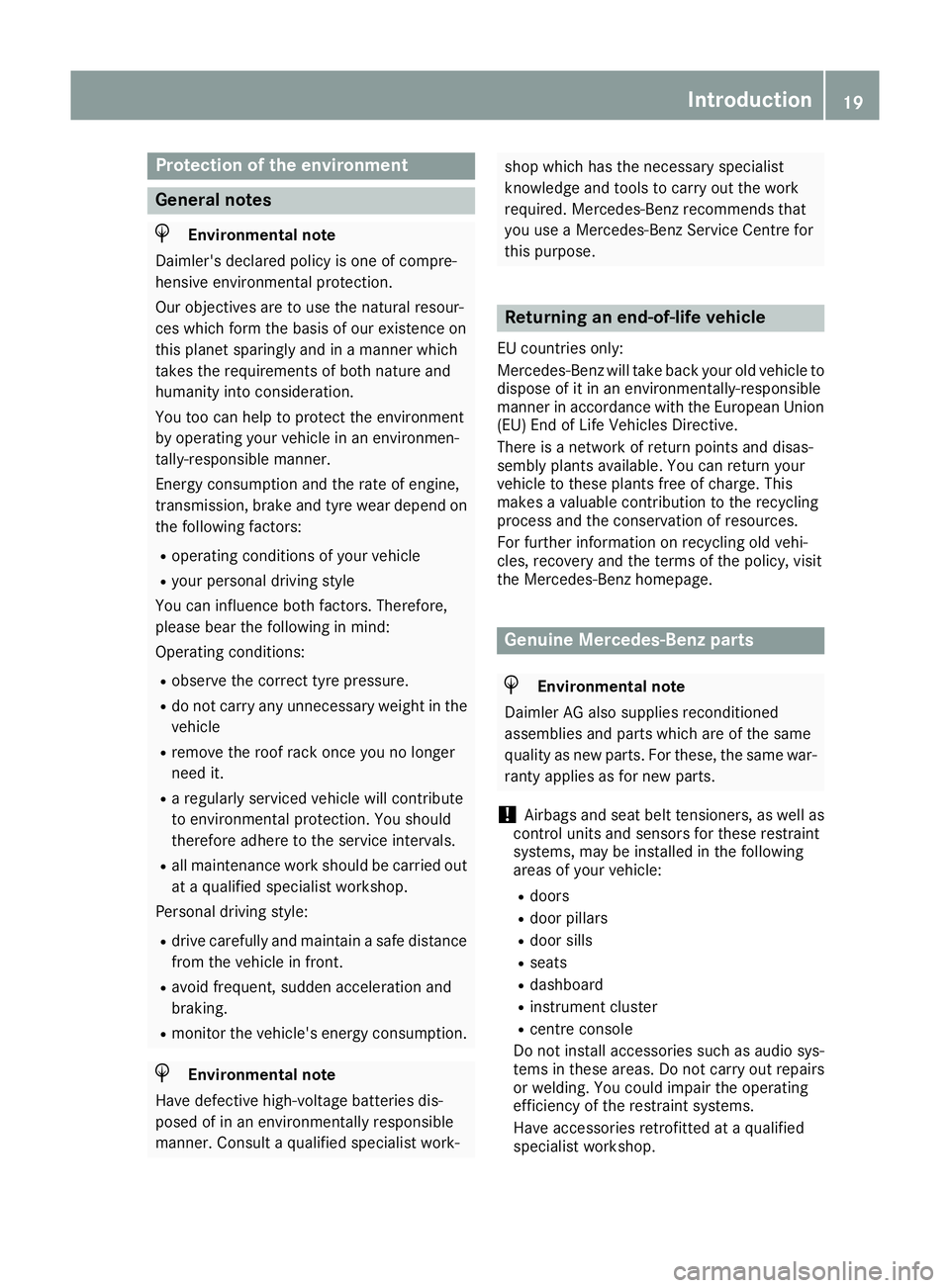
Protection of the environment
General notes
H
Environmental note
Daimler's declared policy is one of compre-
hensive environmental protection.
Our objectives are to use the natural resour-
ces which form the basis of our existence on
this planet sparingly and in a manner which
takes the requirements of both nature and
humanity into consideration.
You too can help to protect the environment
by operating your vehicle in an environmen-
tally-responsible manner.
Energy consumption and the rate of engine,
transmission, brake and tyre wear depend on
the following factors:
R operating conditions of your vehicle
R your personal driving style
You can influence both factors. Therefore,
please bear the following in mind:
Operating conditions:
R observe the correct tyre pressure.
R do not carry any unnecessary weight in the
vehicle
R remove the roof rack once you no longer
need it.
R a regularly serviced vehicle will contribute
to environmental protection. You should
therefore adhere to the service intervals.
R all maintenance work should be carried out
at a qualified specialist workshop.
Personal driving style:
R drive carefully and maintain a safe distance
from the vehicle in front.
R avoid frequent, sudden acceleration and
braking.
R monitor the vehicle's energy consumption. H
Environmental note
Have defective high-voltage batteries dis-
posed of in an environmentally responsible
manner. Consult a qualified specialist work- shop which has the necessary specialist
knowledge and tools to carry out the work
required. Mercedes-Benz recommends that
you use a Mercedes-Benz Service Centre for
this purpose.
Returning an end-of-life vehicle
EU countries only:
Mercedes-Benz will take back your old vehicle to dispose of it in an environmentally-responsible
manner in accordance with the European Union
(EU) End of Life Vehicles Directive.
There is a network of return points and disas-
sembly plants available. You can return your
vehicle to these plants free of charge. This
makes a valuable contribution to the recycling
process and the conservation of resources.
For further information on recycling old vehi-
cles, recovery and the terms of the policy, visit
the Mercedes-Benz homepage. Genuine Mercedes-Benz parts
H
Environmental note
Daimler AG also supplies reconditioned
assemblies and parts which are of the same
quality as new parts. For these, the same war-
ranty applies as for new parts.
! Airbags and seat belt tensioners, as well as
control units and sensors for these restraint
systems, may be installed in the following
areas of your vehicle:
R doors
R door pillars
R door sills
R seats
R dashboard
R instrument cluster
R centre console
Do not install accessories such as audio sys-
tems in these areas. Do not carry out repairs
or welding. You could impair the operating
efficiency of the restraint systems.
Have accessories retrofitted at a qualified
specialist workshop. Introduction
19 Z
Page 36 of 293
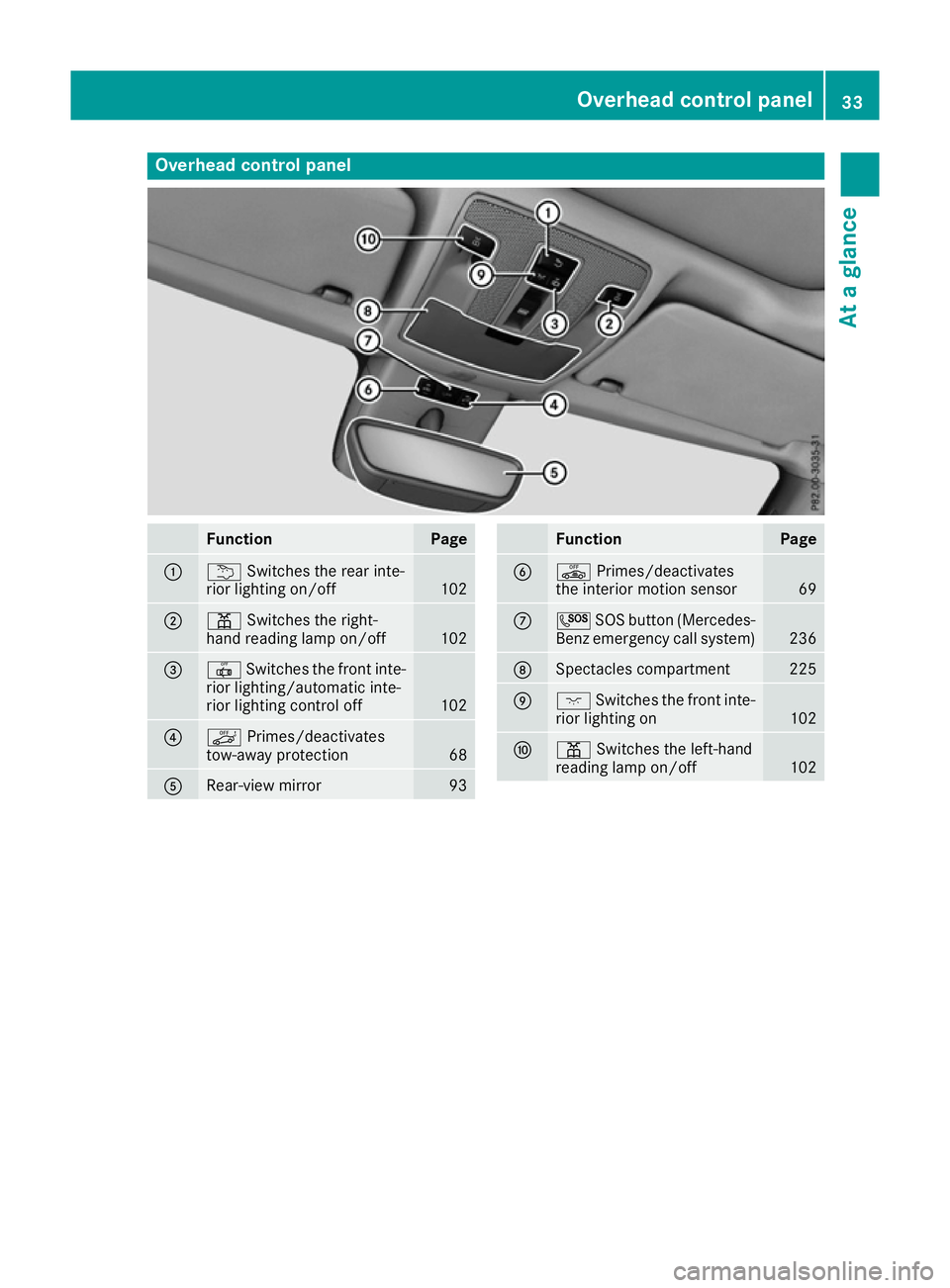
Overhead control panel
Function Page
:
u
Switches the rear inte-
rior lighting on/off 102
;
p
Switches the right-
hand reading lamp on/off 102
=
|
Switches the front inte-
rior lighting/automatic inte-
rior lighting control off 102
?
ë
Primes/deactivates
tow-away protection 68
A
Rear-view mirror 93 Function Page
B
ê
Primes/deactivates
the interior motion sensor 69
C
G
SOS button (Mercedes-
Benz emergency call system) 236
D
Spectacles compartment 225
E
c
Switches the front inte-
rior lighting on 102
F
p
Switches the left-hand
reading lamp on/off 102Overhead control panel
33At a glance
Page 43 of 293
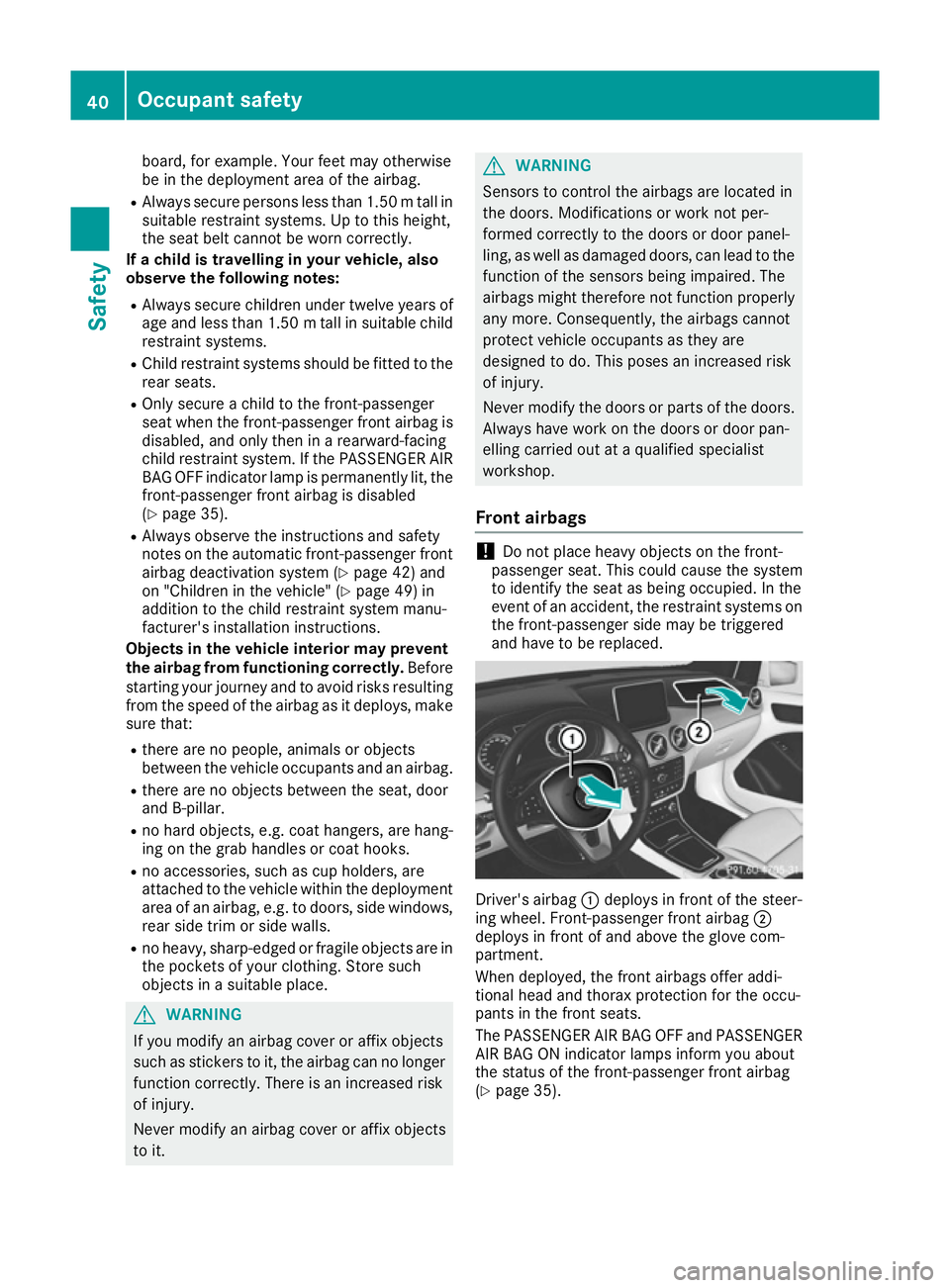
board, for example. Your feet may otherwise
be in the deployment area of the airbag.
R Always secure persons less than 1.50 mtall in
suitable restraint systems. Up to this height,
the seat belt cannot be worn correctly.
If a child is travelling in your vehicle, also
observe the following notes:
R Always secure children under twelve years of
age and less than 1.50 mtall in suitable child
restraint systems.
R Child restraint systems should be fitted to the
rear seats.
R Only secure a child to the front-passenger
seat when the front-passenger front airbag is
disabled, and only then in a rearward-facing
child restraint system. If the PASSENGER AIR BAG OFF indicator lamp is permanently lit, the
front-passenger front airbag is disabled
(Y page 35).
R Always observe the instructions and safety
notes on the automatic front-passenger front
airbag deactivation system (Y page 42) and
on "Children in the vehicle" (Y page 49) in
addition to the child restraint system manu-
facturer's installation instructions.
Objects in the vehicle interior may prevent
the airbag from functioning correctly. Before
starting your journey and to avoid risks resulting
from the speed of the airbag as it deploys, make sure that:
R there are no people, animals or objects
between the vehicle occupants and an airbag.
R there are no objects between the seat, door
and B-pillar.
R no hard objects, e.g. coat hangers, are hang-
ing on the grab handles or coat hooks.
R no accessories, such as cup holders, are
attached to the vehicle within the deployment
area of an airbag, e.g. to doors, side windows, rear side trim or side walls.
R no heavy, sharp-edged or fragile objects are in
the pockets of your clothing. Store such
objects in a suitable place. G
WARNING
If you modify an airbag cover or affix objects
such as stickers to it, the airbag can no longer function correctly. There is an increased risk
of injury.
Never modify an airbag cover or affix objects
to it. G
WARNING
Sensors to control the airbags are located in
the doors. Modifications or work not per-
formed correctly to the doors or door panel-
ling, as well as damaged doors, can lead to the function of the sensors being impaired. The
airbags might therefore not function properly any more. Consequently, the airbags cannot
protect vehicle occupants as they are
designed to do. This poses an increased risk
of injury.
Never modify the doors or parts of the doors.
Always have work on the doors or door pan-
elling carried out at a qualified specialist
workshop.
Front airbags !
Do not place heavy objects on the front-
passenger seat. This could cause the system
to identify the seat as being occupied. In the
event of an accident, the restraint systems on
the front-passenger side may be triggered
and have to be replaced. Driver's airbag
:deploys in front of the steer-
ing wheel. Front-passenger front airbag ;
deploys in front of and above the glove com-
partment.
When deployed, the front airbags offer addi-
tional head and thorax protection for the occu-
pants in the front seats.
The PASSENGER AIR BAG OFF and PASSENGER
AIR BAG ON indicator lamps inform you about
the status of the front-passenger front airbag
(Y page 35). 40
Occupant safetySafety
Page 66 of 293
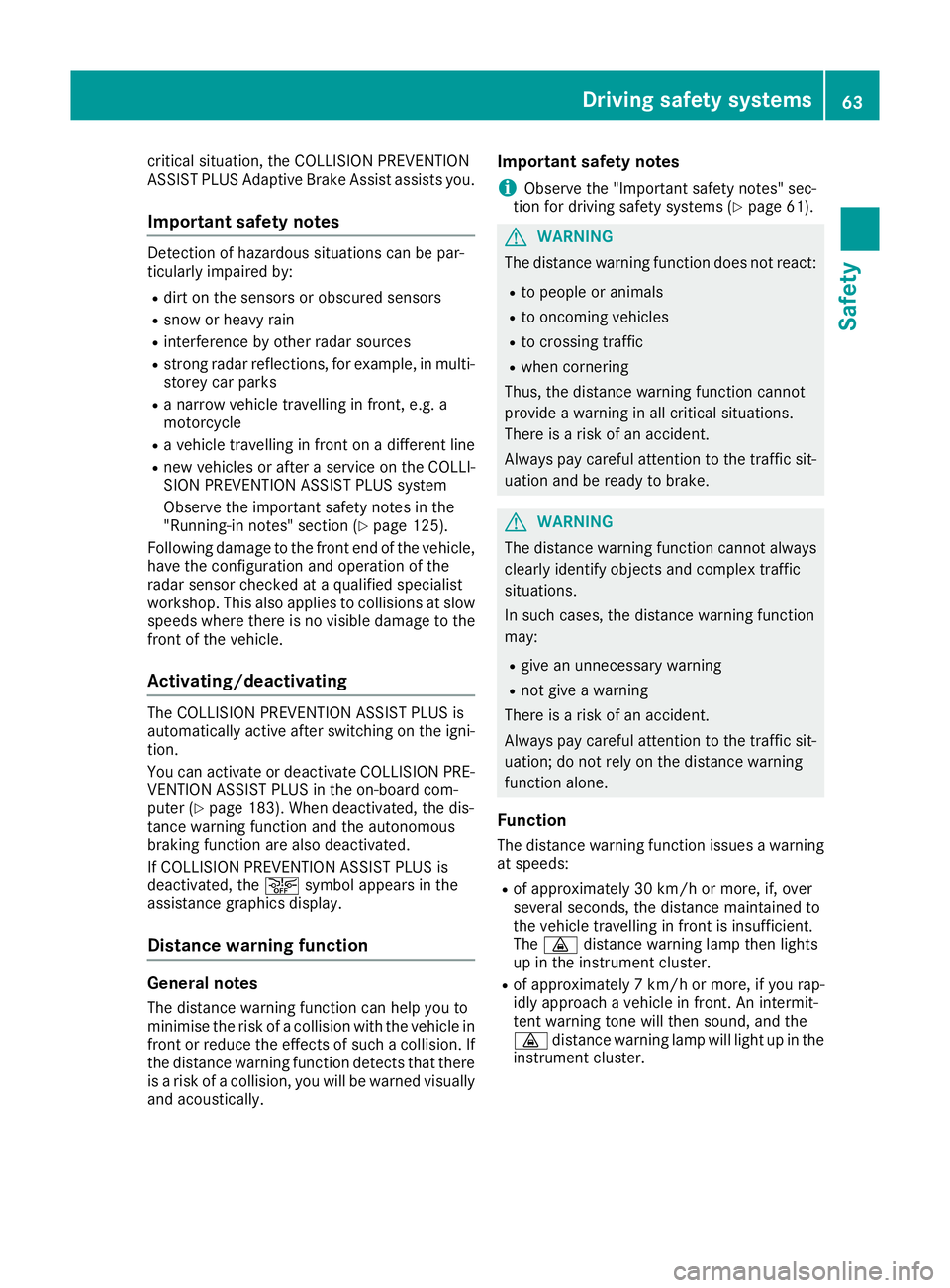
critical situation, the COLLISION PREVENTION
ASSIST PLUS Adaptive Brake Assist assists you.
Important safety notes Detection of hazardous situations can be par-
ticularly impaired by:
R
dirt on the sensors or obscured sensors
R snow or heavy rain
R interference by other radar sources
R strong radar reflections, for example, in multi-
storey car parks
R a narrow vehicle travelling in front, e.g. a
motorcycle
R a vehicle travelling in front on a different line
R new vehicles or after a service on the COLLI-
SION PREVENTION ASSIST PLUS system
Observe the important safety notes in the
"Running-in notes" section (Y page 125).
Following damage to the front end of the vehicle,
have the configuration and operation of the
radar sensor checked at a qualified specialist
workshop. This also applies to collisions at slow speeds where there is no visible damage to thefront of the vehicle.
Activating/deactivating The COLLISION PREVENTION ASSIST PLUS is
automatically active after switching on the igni-
tion.
You can activate or deactivate COLLISION PRE-
VENTION ASSIST PLUS in the on-board com-
puter (Y page 183). When deactivated, the dis-
tance warning function and the autonomous
braking function are also deactivated.
If COLLISION PREVENTION ASSIST PLUS is
deactivated, the æsymbol appears in the
assistance graphics display.
Distance warning function General notes
The distance warning function can help you to
minimise the risk of a collision with the vehicle in
front or reduce the effects of such a collision. If the distance warning function detects that there
is a risk of a collision, you will be warned visually and acoustically. Important safety notes
i Observe the "Important safety notes" sec-
tion for driving safety systems (Y page 61). G
WARNING
The distance warning function does not react:
R to people or animals
R to oncoming vehicles
R to crossing traffic
R when cornering
Thus, the distance warning function cannot
provide a warning in all critical situations.
There is a risk of an accident.
Always pay careful attention to the traffic sit-
uation and be ready to brake. G
WARNING
The distance warning function cannot always
clearly identify objects and complex traffic
situations.
In such cases, the distance warning function
may:
R give an unnecessary warning
R not give a warning
There is a risk of an accident.
Always pay careful attention to the traffic sit-
uation; do not rely on the distance warning
function alone.
Function The distance warning function issues a warning at speeds:
R of approximately 30 km/h or more, if, over
several seconds, the distance maintained to
the vehicle travelling in front is insufficient.
The · distance warning lamp then lights
up in the instrument cluster.
R of approximately 7 km/h or more, if you rap-
idly approach a vehicle in front. An intermit-
tent warning tone will then sound, and the
· distance warning lamp will light up in the
instrument cluster. Driving safety systems
63Safety Z
Page 67 of 293
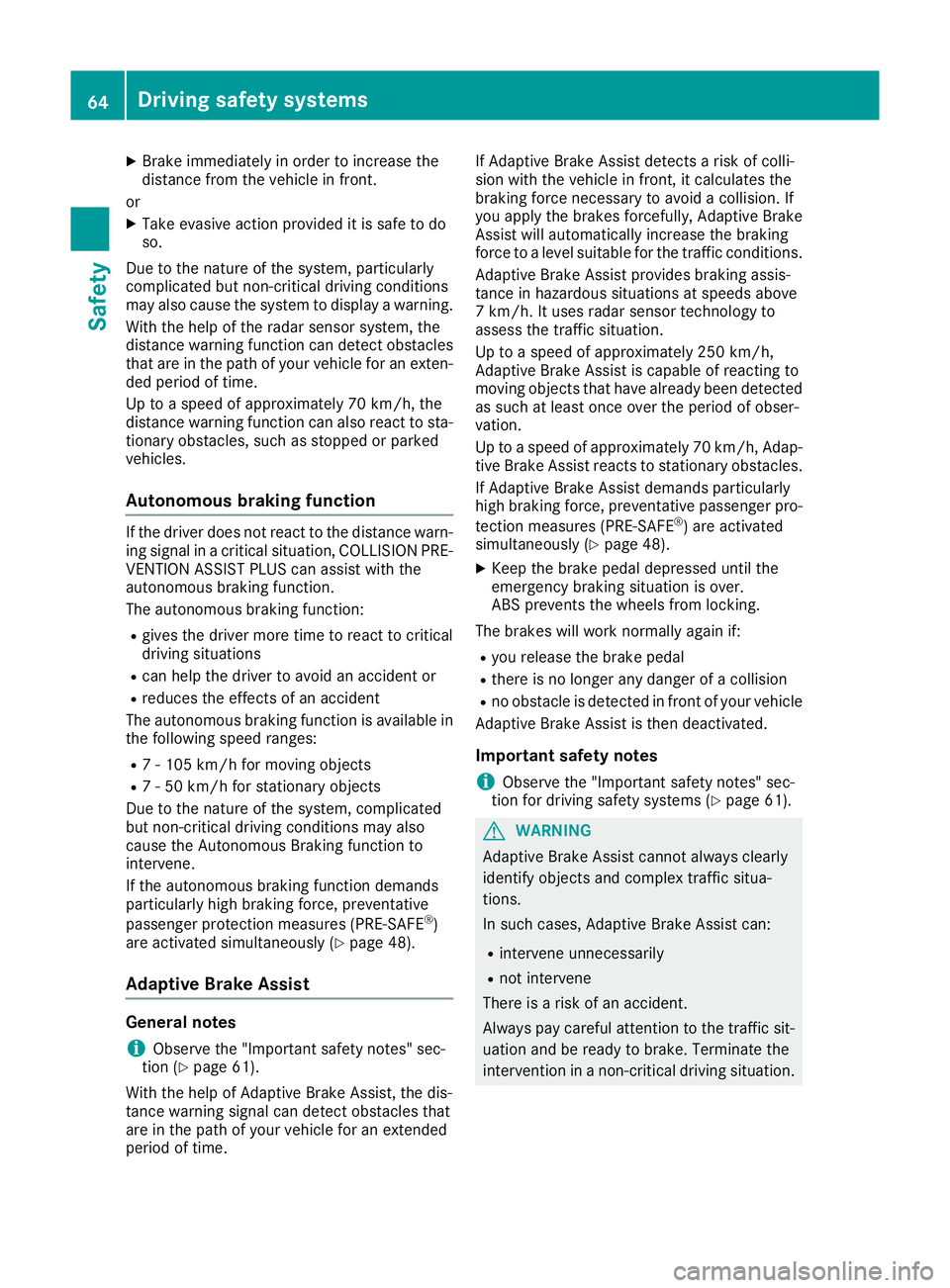
X
Brake immediately in order to increase the
distance from the vehicle in front.
or X Take evasive action provided it is safe to do
so.
Due to the nature of the system, particularly
complicated but non-critical driving conditions
may also cause the system to display a warning.
With the help of the radar sensor system, the
distance warning function can detect obstacles
that are in the path of your vehicle for an exten-
ded period of time.
Up to a speed of approximately 70 km/h, the
distance warning function can also react to sta-
tionary obstacles, such as stopped or parked
vehicles.
Autonomous braking function If the driver does not react to the distance warn-
ing signal in a critical situation, COLLISION PRE- VENTION ASSIST PLUS can assist with the
autonomous braking function.
The autonomous braking function:
R gives the driver more time to react to critical
driving situations
R can help the driver to avoid an accident or
R reduces the effects of an accident
The autonomous braking function is available in
the following speed ranges:
R 7 - 105 km/h for moving objects
R 7 - 50 km/h for stationary objects
Due to the nature of the system, complicated
but non-critical driving conditions may also
cause the Autonomous Braking function to
intervene.
If the autonomous braking function demands
particularly high braking force, preventative
passenger protection measures (PRE-SAFE ®
)
are activated simultaneously (Y page 48).
Adaptive Brake Assist General notes
i Observe the "Important safety notes" sec-
tion (Y page 61).
With the help of Adaptive Brake Assist, the dis-
tance warning signal can detect obstacles that
are in the path of your vehicle for an extended
period of time. If Adaptive Brake Assist detects a risk of colli-
sion with the vehicle in front, it calculates the
braking force necessary to avoid a collision. If
you apply the brakes forcefully, Adaptive Brake
Assist will automatically increase the braking
force to a level suitable for the traffic conditions.
Adaptive Brake Assist provides braking assis-
tance in hazardous situations at speeds above
7 km/h. It uses radar sensor technology to
assess the traffic situation.
Up to a speed of approximately 250 km/h,
Adaptive Brake Assist is capable of reacting to
moving objects that have already been detected
as such at least once over the period of obser-
vation.
Up to a speed of approximately 70 km/h, Adap-
tive Brake Assist reacts to stationary obstacles.
If Adaptive Brake Assist demands particularly
high braking force, preventative passenger pro-
tection measures (PRE-SAFE ®
) are activated
simultaneously (Y page 48).
X Keep the brake pedal depressed until the
emergency braking situation is over.
ABS prevents the wheels from locking.
The brakes will work normally again if: R you release the brake pedal
R there is no longer any danger of a collision
R no obstacle is detected in front of your vehicle
Adaptive Brake Assist is then deactivated.
Important safety notes
i Observe the "Important safety notes" sec-
tion for driving safety systems (Y page 61). G
WARNING
Adaptive Brake Assist cannot always clearly
identify objects and complex traffic situa-
tions.
In such cases, Adaptive Brake Assist can:
R intervene unnecessarily
R not intervene
There is a risk of an accident.
Always pay careful attention to the traffic sit- uation and be ready to brake. Terminate the
intervention in a non-critical driving situation. 64
Driving safety systemsSafety